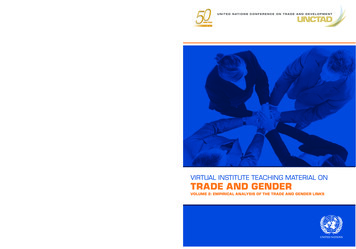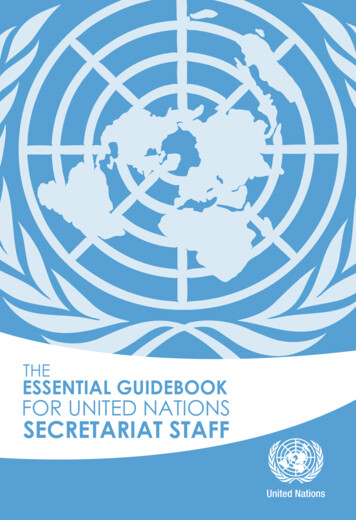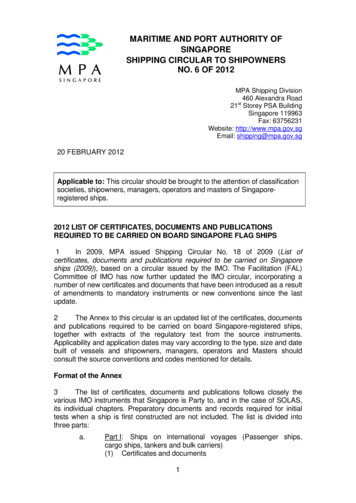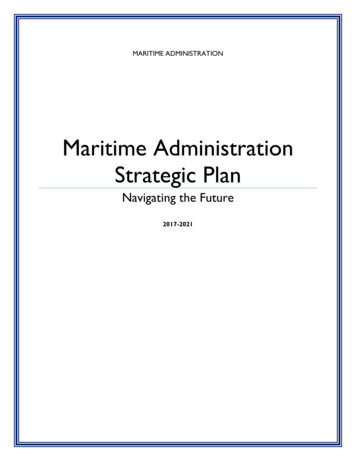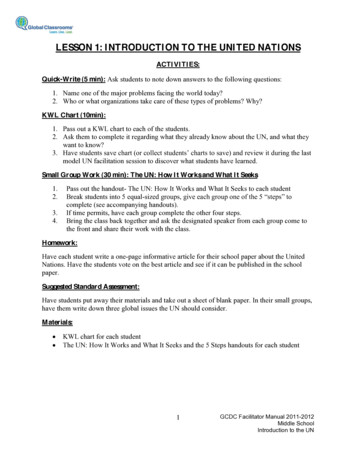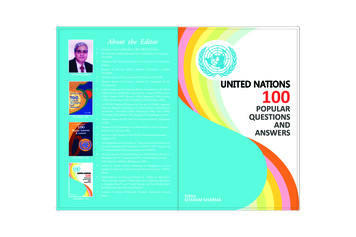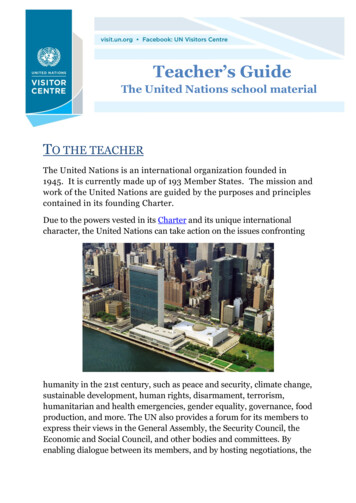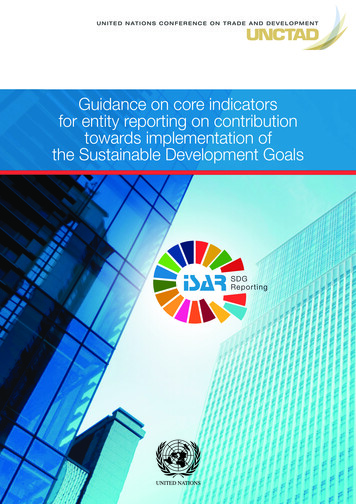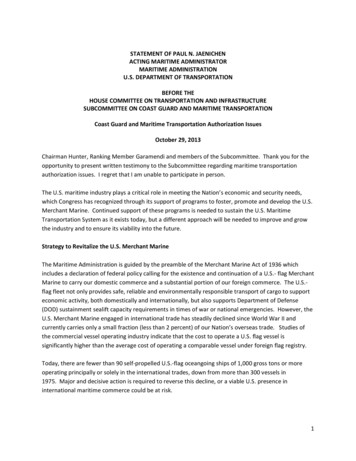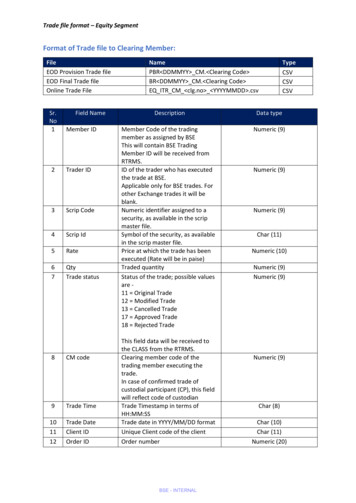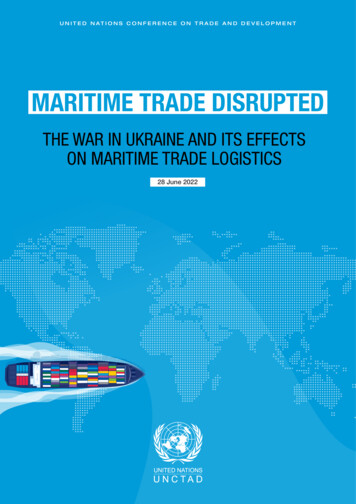
Transcription
U N I T E D N AT I O N S C O N F E R E N C E O N T R A D E A N D D E V E L O P M E N TMARITIME TRADE DISRUPTEDTHE WAR IN UKRAINE AND ITS EFFECTSON MARITIME TRADE LOGISTICS28 June 2022
The war in the Ukraine is stifling trade and logistics of Ukraine and the Black Searegion. The search for alternate trade routes for Ukrainian goods has rapidly increasedthe demands on land and maritime transport infrastructure and services.For Ukraine’s trading partners, many commodities now have to be sourced from furtheraway. This has increased global vessel demand and the cost of shipping around theworld.Grains are of particular concern given the leading role of the Russian Federation andUkraine in agrifood markets, and its nexus to food security and poverty reduction.Grain prices and shipping costs have been on the rise since 2020, but the war inUkraine has exacerbated this trend and reversed a temporary decline in shippingprices. Between February and May 2022, the price paid for the transport of dry bulkgoods- such as grains- increased by nearly 60 per cent. The concomitant increase ofgrain prices and freight rates would lead to a nearly 4 per cent increase in consumerfood prices globally. Almost half of this impact is due to higher shipping costs.The Russian Federation is a giant in the global market for fuel and fertilizer, whichare key inputs for farmers worldwide. Disruptions in their supply can lead to lowergrain yields and higher prices, with serious consequences for global food security,particularly in vulnerable and food-import dependent economies.The Russian Federation is also a leading oil and gas exporter. Confronted with traderestrictions and logistical challenges, the cost of oil and gas has increased as alternativesources of supply, often at more distant locations, are called upon.Higher energy costs have led to higher marine bunker prices, increasing shipping costsfor all sectors. By the end of May 2022, the global average price for very low sulphurfuel oil (VLSFO) had increased by 64 per cent with respect to the start of the year.Taken altogether, these increased costs imply higher prices for consumers and threatento widen the poverty gap.Global trade depends on a complex system of ports and ships that connect the world.If global trade is to flow more smoothly, it must be ensured that Ukrainian ports areopen to international shipping and that collaboration among transport stakeholderscontinues to provide services. Alternative ways of transport must also be pursued. Andinvestment in transport and trade facilitation should be fostered as well as the supportfor the most vulnerable economies.MARITIME TRADE DISRUPTEDThe war in Ukraine and its effects on maritime trade logistics2
CONTENTS1Shipping costsare rising2Fewer grainshipments overlonger distanceslead to higherfood prices3Containershipping andglobal valuechains aredisrupted tooWhat canbe done?Click on the iconto interact with the chartMARITIME TRADE DISRUPTEDThe war in ukraine and its effects on trade logistics3
1Shipping costs arerisingDisrupted regional logistics, the halting of port operations in Ukraine, the destruction of important infrastructure,trade restrictions, increased insurance costs, and higher fuel prices, have all contributed to the logistical hurdlesarising in the Black Sea region. They have also contributed to a more costly and unpredictable global tradingand shipping environment. Many countries have had to look further afield for suppliers of oil, gas and grain.Consequently, shipping distances increased, along with transit times and costs.It is not possible to associate all developments in global shipping with a specific cause. The war in Ukraine isone of several major issues currently affecting international maritime transport, compounding other challengessuch as the COVID-19 pandemic, port congestion, the need to switch to low carbon fuels, to name but a few.Nevertheless, it is clear that the disruptions and the higher ton-mile demand caused by the war in Ukrainecontribute strongly to higher shipping costs (figure 1).Figure 1. The price of shipping is rising againClarksea index in dollars/day, all shipping markets50 000War in Ukraine40 000COVID-19 pandemic effect30 00020 00010 ource: UNCTAD, based on data provided by Clarksons Research Shipping Intelligence Network.Note: The series tracks average vessel earnings across the major shipping sectors, including tankers, bulkers, containerships and gas carriers,weighted by the number of ships in each segment.Higher energy prices exacerbate the challenges faced by shippers. The Russian Federation is a leading oil andgas exporter. However, trade restrictions and shifts in trading patterns resulting from the war have led to a surgein ton-mile demand. Daily rates for smaller-size tankers, which are key for regional oil trading in the Black Sea,Baltic Sea and Mediterranean Sea regions, have dramatically increased.The higher energy costs have also led to higher marine bunker prices, raising shipping costs for all maritimetransport sectors. By the end of May 2022, the global average price for very low sulphur fuel oil (VLSFO)reached over 1,000 per ton, a 64 per cent increase with respect to the start of the year – and the average fuelsurcharges charged by container shipping lines have risen close to 50 per cent since the beginning of the war.MARITIME TRADE DISRUPTEDThe war in Ukraine and its effects on maritime trade logistics4
2Fewer grain shipmentsover longer distances lead tohigher food pricesThe Russian Federation and Ukraine are prominent players in agrifood markets, including animal feed. Together,they account for 53 per cent of global trade in sunflower oil and seeds, and 27 per cent of wheat.1A total of 36 countries import more than 50 per cent of their wheat from the Russian Federation and Ukrainealone.2 Ukraine exported around 50 million tons of grain in 2021. Before the war, estimates projected a growthof 3 per cent in global sea exports of grain. Now, however, they are projected to shrink by 3.8 per cent in 2022.Global shipments of fertilizer and its inputs such as potash are projected to drop by 7 per cent in 2022.3Reduced grain exports from Ukraine are partly offset by increased shipments from other suppliers. For example,Brazil is expected to increase its wheat and coarse grain exports by an impressive 37 per cent in 2022.Together, the United Kingdom of Great Britain and Northern Ireland and the European Union are set to expandtheir exports by 8 per cent during the same year. Soybean exports are expected to increase from Argentina,Brazil and the United States of America.4 In the medium term, Australia, Brazil and the United States can beexpected to compensate for reduced grain exports into North Africa and the Middle East.Despite the overall reduction of volumes for shipping, the demand for transport work – i.e. ton-miles – for thefood-importing countries is likely to increase, as the alternative cargos are sourced from further away.Changing port calls and logistical challengesThe shift in grain trading patterns is reflected in port calls by dry bulk vessels in the Black Sea. Black Sea portsnormally served more than 90 per cent of Ukrainian overseas grain shipments. With port operations suspended,overseas grain dispatches have been limited to deliveries via western borders, by rail, as well as through thesmall ports of Reni and Izmail on the Danube River. These alternatives are not sufficient to compensate for thelost capacity normally provided by Ukrainian Black Sea ports.Since the start of the war, weekly port calls have gone from 60 to almost zero in Ukraine, and declinedsomewhat in the Russian Federation and Türkiye since the start of the war. Meanwhile, dry bulk vessel callshave seen small increases at ports in Bulgaria and Romania, reflecting the re routing of some of the trade fromUkraine (figure 2).UNCTAD (2022). The impact on trade and development of the war in Ukraine. UNCTAD Rapid Assessment. 16 ument/osginf2022d1 en.pdf.12UNCTAD (2022). Global Impact of war in Ukraine on food, energy and finance systems. Briefing Note No. 1. 13 April.3Clarksons Research Studies, Dry Bulk Trade Outlook, Volume 28, No. 4, April 2022.4Ibid.MARITIME TRADE DISRUPTEDThe war in Ukraine and its effects on maritime trade logistics5
Figure 2: The changing pattern of port calls of dry bulk in the Black Sea regionNumber of port calls of dry bulk in the Black Sea region, by week, 2021 and 2022Arrivals, 2021Arrivals, 2022UkraineRussian Federation5008025040060200Black Sea kiye2022,100201000150402503020025secondquarter 2Bulgaria201500524681012141602Source: UNCTAD, based on data provided by Marine Traffic.Note: Russian Federation and Türkiye include ports outside the Black Sea region. Figures for the Black Sea region include Georgia and the Republic of Moldova.The vertical lines at week 8 indicate the beginning of the war in 2022.Some of the Ukrainian grains are transported by rail and trans-shipped at ports in Bulgaria and Romania.However, existing grain storage capacity is already committed to last year’s harvest, leading to concerns thatthe new harvest cannot be stored and, therefore, will be damaged.Box 1: Logistical challenges for the Ukrainian harvestIn Ukraine, due to the hostilities, many grain elevators are unable to take pest control measures, protect grain from rainfall,or stir it to prevent self-heating, thus, increasing risks of quality deterioration. If export transport capacity continues to belimited, next year’s crops become uncertain, further aggravating the food shortage spectre. Even an immediate re-openingof Ukrainian seaports would still be too late for some of the 2022 harvest season, as logistics and human resources maynot be arranged in time.Nearly all of Ukraine’s grain exports are carried out through seaports on the Black Sea and the Sea of Azov. Commercialvessels, including those loaded with grains and other agricultural commodities, are prevented from leaving the ports. Themilitary action and damage to logistics and infrastructure in Ukraine has immediate and potentially long-term consequenceson global grains and oilseeds trade and supplies to susceptible regions, including Africa, Asia and the Near East.It is important to restore safe access for Ukrainian farmers and producers to fields and infrastructure related to theproduction and transportation of grains. With the imminent start of winter wheat harvesting and spring grains and oilseedsplanting, the next few months will be a crucial period for farmers in Ukraine. Safe access to fields and adequate supply ofseeds, fuel and fertilizers are among the main factors needed in Ukraine to achieve a successful harvest in order to ensuredomestic food security and contribute to the global food balance.There is a need to combine additional mobile storage facilities in Ukraine and in neighbouring countries with the use of therailway, road and waterway networks. Logistical challenges remain a key obstacle however, with different rail gauges andtransit procedures undermining the smooth flow of trade. Competing demands from neighbouring countries’ producersand trades, insurance costs, congestion and lack of pilots for waterway transport, further compound the logistical crunch.Source: UNCTAD, based on information provided by the International Grains Council, www.igc.int.MARITIME TRADE DISRUPTEDThe war in Ukraine and its effects on maritime trade logistics6
Higher freight rates and higher food pricesBetween February 2022 and May 2022, the BalticDry Index - a global benchmark for dry bulk freightrates – increased by 59 per cent. This could lead to anadditional increase of 3.7 per cent in consumer foodprices globally. Almost half of this increase is due tohigher transport costs, resulting from higher freightrates and longer distances (figure 3).Middle-income economies are expected to experienceslightly higher food prices increases as their foodimports depend on dry bulk shipping more than theglobal average (figure 4). The impact of the dry bulkfreight rate surge on low-income economies is expectedto be smaller. Their food imports are concentrated onprocessed rather than primary food products (figure 5),partly due to their low capacity to process food.Impact from global grain pricesImpact from dry bulk freight rates5.0%4.2%3.7%3.4%4.0Impact from global grain pricesImpact from dry bulk freight ource: UNCTAD, based on data provided by Clarksons Research ShippingIntelligence Network, IMF, International44% Financial Statistics, Direction ofTrade Statistics and40%Consumer Price Index, UNCTAD Statistics and the WorldBank, World Integrated Trade Solutions, Commodity Price Data and A GlobalDatabase of Inflation.31%44%40%2.9%3.02.1%31%2.0Figure 4: Middle-income economies are more dependent on1.0ships to import grainsShare of grains imported by dry bulk ships in total food imports,selected countrygroupings,HighUpper 2019LowerLowWorldincomeFigure 3: Higher freight rates and grain prices meanhigher food pricesImpact of higher dry bulk freight rates and global grain priceson consumer food prices, selected country groupingsmiddleincome40%middleincomeincome20% 5: Low-income countries depend19% more onFigureprocessed than primary food products in food imports.Share of primary and processed food products in foodimports mainly for household consumption, selectedcountry groupings, 202020%19%LowLowerUpperWorldHighmiddleProcessed foodproductsmiddlePrimaryincomefood dleincomeLowermiddleincomeLowincomeWorldSource: UNCTAD, based on data provided by Sea/Live (https://www.sea.live/)and the Food and Agriculture Organization of the United Nations, food omeLowincomeWorldSource: UNCTAD, based on data provided by Sea/Net and FAO and WorldBank Integrated Trade Solutions.Ha, Jongrim, M. Ayhan Kose and Franziska Ohnsorge (2021). "One-Stop Source: A Global Database of Inflation." Policy ResearchWorking Paper 9737. World Bank, Washington, D.C.5Scenario with a 59 per cent dry bulk freight rate increase and a 19 per cent global grain price increase compared to no increase (i.e.same freight rate and grain price levels as February 2022) as a percentage of the consumer food price level. The assumptions are basedon a 59 per cent increase in the Baltic Dry Index between February 2022 and May 2022 and a 19 per cent increase in the global grainsprice index between February 2022 and April 2022. The simulation methodology is similar to the one used in chapter 3 of Review ofMaritime Transport 2021 (http://unctad.org/RMT).6MARITIME TRADE DISRUPTEDThe war in Ukraine and its effects on maritime trade logistics.7
3Container shipping and global value chainsare disrupted tooAlthough the Russian Federation and Ukraine are not deeply integrated into global container shipping and valuechain networks, the conflict and trade restrictions have also affected this shipping segment. Container carrierscut ship carrying capacity assigned to the Russian Federation, and suspended operations at Ukrainian seaports(figure 6). Several neighbouring countries saw ship capacity deployed in their ports increase slightly.As ports closed and carriers discontinued shipping services to the Russian Federation and Ukraine, ships andcontainers had to re route. Cargo destinated for the Russian Federation and Ukraine is now piling up at ports,including Hamburg, Germany; Rotterdam, Netherlands; Constanța, Romania; and Istanbul, Türkiye. Shippersare facing delays and can be expected to see an increase in detention and demurrage charges at ports.Russian Federation cargo is also being stranded at ports e.g. in Europe. This adds pressure on warehousingand storage capacity and drives costs upward. Freight rates had surged since the pandemic and the need toreposition ships and containers during the war adds to upward pressures on freight rates.Figure 6: Going down: container shipping deployment for the Russian Federation and UkraineContainer shipping fleet deployment, selected countries, in TEU viaEstoniaBulgariaUkraineSource: UNCTAD, based on data provided by MDST Transmodal.Note: TEU capacity is the annualized vessel carrying capacity in twenty-foot equivalent units.The UNCTAD simulation concludes that the high container freight costs observed in 2021–2022 will be passedon and lead to an additional increase in consumer prices by 1.6 per cent globally. It also suggests that globalimport price levels will increase on average by 11.9 per cent as a result of sustained freight rate increases.77“Sustainable and resilient transport and trade facilitation in times of pandemic and beyond: Key challenges and opportunities”,UNCTAD, Geneva, 2022, n-ninthsession.MARITIME TRADE DISRUPTEDThe war in Ukraine and its effects on maritime trade logistics8
Small island developing States (SIDS) will be hardest hit with an increase of 8.1 per cent. SIDS import prices canface a cumulative increase of 26.7 per cent. SIDS generate small trade volumes, face stark trade imbalances(i.e. ships tend to be empty on their return voyages), are served by only a few shipping companies and arehighly dependent on energy and consumer goods imports. Their transport expenditure for imports is two tothree times higher than the world average. Not only do SIDS already pay higher transport costs but they alsosee a higher impact on their economies when transport costs increase.8Box 2: Inflationary pressures resulting from higher freight ratesThe COVID-19 pandemic led to a sudden dip in international seaborne trade. But by late 2020 there had been a swiftrebound mainly in container and dry bulk shipping. The asymmetric maritime trade recovery, mainly on East–Westcontainerized trade lanes, increased pressure on supply chains, ports, shipping and trade. The surge in e-commerce,capacity constraints, equipment shortages and renewed virus infections in some parts of the world put supply chainsunder pressure in 2021. Pressure continued in 2022 so far still exhibiting high port congestion and constrained logisticsand transport networks. Median waiting time in ports for container ships increased by almost 20 per cent betweenpandemic times and the end of 2021.Freight rates surged, surcharges proliferated and service reliability declined while delays and dwell times went up. By theend of 2020, container rates were over five times higher than their 2019 levels; although declining, they remain elevated.New disruptions such as the closing of manufacturing activities and ports in China in the first half of 2022 due to newcases of COVID-19 infections have further disrupted the system. Increased costs are a challenge for all traders and supplychains, particularly smaller shippers who are less able to absorb the additional expense and disadvantaged when they arenegotiating rates and booking space on ships.Source: “Sustainable and resilient transport and trade facilitation in times of pandemic and beyond: Key challenges and opportunities”, UNCTAD,Geneva, 2022, n-ninth-session.See “UNCTAD Assessment of the Impact of the IMO Short-Term GHG Reduction Measure on States”, UNCTAD, Geneva, ARITIME TRADE DISRUPTEDThe war in Ukraine and its effects on maritime trade logistics9
What can be done?If global trade is to flow more smoothly in future, and ports and maritime transport are to thrive and navigatethrough the historic disruption caused by the pandemic, this will require policy action. Considering the issuesdiscussed in this briefing note, UNCTAD makes the following six key recommendations as regards maritimetransport challenges:12345There will be no effective solution to the food crisis without reintegratingUkraine’s food production, as well as the food and fertilizer produced by the RussianFederation into world markets – despite the war.Ensure that Ukrainian ports are open to international shipping to allow Ukrainiangrain to reach overseas markets, at lower shipping costs.Lower transaction cost for the food and fertilizer exports of the Russian Federation.Ensure collaboration among vessel flag States, port States and industry continue toprovide all necessary services, including bunkering supplies, health services for sailors,and certification of regulatory compliance. This will help to keep the negative impacts oncosts, insurance premiums and operations to a minimum.Ease the transit and movement of transport workers, albeit temporarily, to lessen thepressure on cross-border trade and transit.6Invest in transport services, as well as trade and transit facilitation even morethan in pre-war times. Trading partners and transit countries should focus on keydeterminants of international transport costs such as trade facilitation and digitalization,infrastructure, economies of scale, imbalances and ensuring competition.97Support developing countries (including MICS), especially the most vulnerableeconomies such as SIDS, LDCs and net food importers. The war in Ukraineadds to the challenges posed by the COVID-19 pandemic and the climate crisis.The international community’s support is needed to provide financial and technicalassistance related to transport and trade facilitation.10See UNCTAD, 2015, Review of Maritime Transport, for a detailed assessment of determinants of maritime transport ransport-20159See Rebeca Grynspan, “Weathering a ‘perfect storm’ of cascading perfect-storm-cascading-crises10MARITIME TRADE DISRUPTEDThe war in Ukraine and its effects on maritime trade logistics10
eunctad.org/flickrUNCTAD/OSG/INF/2022/2 - This publication has not been formally edited.unctad.org/linkedin
For Ukraine's trading partners, many commodities now have to be sourced from further . goods- such as grains- increased by nearly 60 per cent. The concomitant increase of . second quarter 2020, third quarter 2020, fourth quarter 2021, first quarter 2021, second quarter 2022, first quarter 2022,
